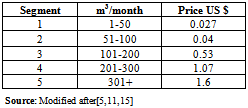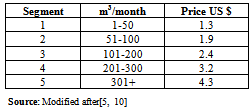-
Paper Information
- Previous Paper
- Paper Submission
-
Journal Information
- About This Journal
- Editorial Board
- Current Issue
- Archive
- Author Guidelines
- Contact Us
World Environment
p-ISSN: 2163-1573 e-ISSN: 2163-1581
2013; 3(2): 66-70
doi:10.5923/j.env.20130302.05
Review of Saudi Arabia Municipal Water Tariff
Omar K M Ouda
Department of Civil Engineering, Prince Mohamed Bin Fahd University, Al Khobar, Kingdom of Saudi Arabia
Correspondence to: Omar K M Ouda, Department of Civil Engineering, Prince Mohamed Bin Fahd University, Al Khobar, Kingdom of Saudi Arabia.
| Email: |  |
Copyright © 2012 Scientific & Academic Publishing. All Rights Reserved.
Kingdom of Saudi Arabian (KSA) has a harsh desert environment and faces a chronic water shortage problem. KSA is heavily depending on expensive desalinated water for municipal demand. The country is currently implementing an economically inefficient water tariff system. This research reviews the water tariff system and the potable water production cost in Saudi Arabia. Assessment of the current and future financial consequence of the current water tariff system was conducted. Recommendations towards increasing the efficiency of the water tariff system as water demand management tools were developed. The research results showed that the KSA current water tariff system is heavily subsidized by the government where people pay less than 5% of the water production cost. Given the low cost recovery and the rapidly increasing demand, water subsidy will become a very heavy load on the country’s budget. The government subsidy to water production will dramatically increase and will reach about 6,472 million US$ by the year 2020. Comprehensive restructuring of the KSA water tariff system is highly recommended. The water tariff restructuring objectives should be increasing the efficiency of water tariff as demand management tool and alleviating the subsidy burden on Saudi economy. The Kingdom socio-economical characteristics should be highly considered while developing the new tariff system implementation plan.
Keywords: Saudi Arabia, Water Tariff, Water Production Cost, Water Demand Management
Cite this paper: Omar K M Ouda, Review of Saudi Arabia Municipal Water Tariff, World Environment, Vol. 3 No. 2, 2013, pp. 66-70. doi: 10.5923/j.env.20130302.05.
Article Outline
1. Introduction
- In January 1992, more than five hundred water resources experts and officials attended the International Conference on Water and the Environment (ICWE) in Dublin, Ireland. The conference adapted four principles that governed water resources management for the last two decades in most countries. The Fourth Principle stated” Water has an economic value in all its competing uses and should be recognized as an economic good”[1]. Application of economic principles for water allocation is acceptable and provides tools for efficient development of water services even though water is not supposed to be considered as a commodity for basic domestic needs[2]. In developing countries more evaluation, study and analysis are needed before deciding if water is an economic or a common good[3]. Water is essential for basic human needs and access to minimum quantity of 20 litres per capita per day should be granted to everybody[3]. Water tariff is applied by local water authorities to increase the economical efficiency of water services. The water tariff system should be developed under consideration of basic human water need, water resources availability, and local socio-economical conditions. Low water tariff will have substantial financial price to be paid by local authorities, while high tariff may resulted in significant social and economical consequences. Water tariff is also an efficient water demand management tool. A well designed water tariff system will increase domestic water using efficiency. Water tariff system should be developed to be an economic instrument to set awards for water conservations[4]. Increasing water using efficiency is critical to area with limited water resources such as the Kingdom of Saudi Arabia (KSA). KSA is located at south-western Asia between Red Sea and Arabian Gulf with a total area of about 2 million square kilometres as shown in Figure 1[5]. It occupies about four-fifth of the Arab Peninsula of which about 40% are desert lands. The KSA characterized by very hot summer (May to October) and dry cold winter. In the last four decades, KSA population increased from about 7 million to about 27 million with a growth rate of 3.4% annually[6]. KSA owns huge crude oil reserve and is currently the largest oil producer in the Globe. The crude oil revenue has initiated comprehensive country wide development in all economical sectors for the last four decades. The development came with substantial increase in the standard of living, urbanization, and ever increasing water consumption in the agricultural, municipal and industrial sectors[7]. KSA is under extreme water shortage condition according to the UNESCO water scarcity index[8]. This research reviews water tariff system and potable water production cost in Saudi Arabia. Assessment of the current and future financial consequences of the current water tariff system was conducted. Recommendations towards increasing the efficiency of water tariff system as demand management tools in KSA were developed.
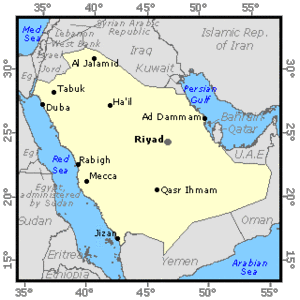 | Figure 1. Saudi Arabia Map. Source: The Encyclopedia of the Earth |
1.1. Potable Water Resources
- KSA is situated in a desert environment with average yearly rainfall of less than 100 mm[6, 8, 9, 10, 11]. There are no perennial surface water courses in the Kingdom. Intermittent flash floods (Wadis) are the only existing surface water body. Runoff quantity and duration is temporarily and spatially varied following the rainfall pattern and distribution. Intermittent flash floods water is captured in 260 irrigation dams collecting an estimated 0.6 Billion m3 per year[4, 11]. The captured water is used for irrigation purposes. The only natural potable water source in the Kingdom is groundwater. Groundwater system consists of renewable and non-renewable aquifers. The non-renewable confined aquifers extend from the northern boundary southwards into the Empty Quarter, and eastwards from the central area to the Arabian Gulf[12]. The aquifer’s water total dissolved solid (TDS) values range from 300 to more than 10,000 part per million[13]. The renewable groundwater system is in the western and south-western part of the Kingdom[12]. The long term total groundwater recharge rate is estimated to be 3.85 billion m3/year[12,13]. The second source of potable water in the Kingdom is desalinated water. KSA Saline Water Conversion Corporation increased desalination plants production capacity from about 200 million m3/year in 1980 to about 1050 million m3/year in 2010[11,13,14]. This made the Kingdom the largest desalinated water producer in the Globe. KSA government is planning to increase the production capacity of desalination plant to about 2.07 billion m3/year by the year 2014[15]. Treated wastewater has been considered as landscape and agricultural irrigation water source in the Kingdom. In 2010, about 240 million m3/year of the treated wastewater have been used across the country. This accounts for about 12% domestic water consumption and 34% of the generated treated wastewater[13].
1.2. Municipal Water Demand
- The total municipal water demand was about 2863 million m3 in 2010 including industrial and domestic water demands[2]. The high population growth and increased standard of living have increased the domestic water demand from 200 million m3/year in 1970 to about 2063 million m3/year in 2010[13]. The domestic water demand growth rate was 6% per year for the last four decades. Saudi Nine National Development Plan is estimating that domestic water demand will increase by 2.1% per year from 2010 to 2014[15]. The average daily per capita water consumption was around 205 litres in 2010[13]. Higher values were reported ranging from 260 Litres per capita per day (LCD) to 300 LCD[12, 16, 17]. Crude oil revenue has posted industrial sector expansion in the Kingdom. The expansion has come with industrial water demand growth rate of about 7.5% per year for the last twenty years[12, 13]. Industrial water demand has increased from 190 million m3 in 1990 to about 800 million m3 in 2010[12, 13]. Saudi Nine National Development Plan is estimating the industrial water demand will increase by 5.5% annually from 2010 to 2014[15]. The agricultural water demand was about 15 billion m3 in 2010[12, 13].The total municipal and agricultural water demand was about 17,863 million m3 in 2010 while water resources yields were about 6,440 million m3. The water shortage was about 11,500 million m3. The water shortage was covered by groundwater over abstraction. KSA has historically considered seawater desalination as a major source for potable water supply. The KSA government continuously expanded desalinated seawater productions to meet municipal water demand in the past. This approach will continue in the future while desalination is the only reliable source for the extra drop of water.
2. Water Production Cost
- Any additional drop of potable water in Saudi Arabia will come specifically from desalination plants. It is reasonable to consider the marginal cost of municipal water is the production cost of desalinated water in Saudi Arabia. Saudi Saline Water Conversion Corporation (SWCC) is responsible for desalinated water production. SWCC operates 30 water desalination plants in the Red Sea coast and the Arabian Gulf coast[18]. The desalinated water production is an expensive process and it is heavily depending on the international energy prices. SWCC data showed an increase in desalinated water production cost from about 0.59 United State Dollar per cubic meter (US$/m3) in 2006 to about 0.8 US$/m3 in 2010 with an average annual rate of 6.3% as shown in Figure 2. The total production and transmission cost has increased from about 0.87 US$/m3 in 2006 to about 1.09 US$/m3 in 2010 with an average annual rate of 4.6%[14].
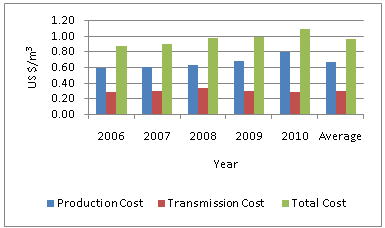 | Figure 2. Desalinated Water Cost in Saudi Arabia |
3. Municipal Water Tariff System
- KSA is adapting block rate water tariff system where water price increases in a systematic way according to consumer consumption rate. The block rate system is in principal very efficient water demand management tools if it is well structured. The current KSA’s water tariff block system is presented in Table 1. The tariff per cubic meter of potable water is US$0.027 for the first fifty cubic meters, US$0.04 for the second fifty cubic meters, US$0.53 for the second one hundred cubic meters, US$1.07 for the third one hundred cubic meters, and US$1.6 for any consumption above 300 cubic meters. Saudi Ministry of Economic and Planning proposed new water tariff system as shown in Table 2[10, 11]. The proposed system has never been approved by the Saudi Government and needs to go through an intensive review and approval process. Potable water tankers are heavily utilized by household to meet their daily demands in many areas across the country especially during the summer time where the water supply network cannot meet daily demand. Water tankers are operated by private sector and regulated by the government. The water tankers price is on average US$1.6 per cubic meter.
|
|
4. Potable Water Cost versus Revenue
- Water demand and water production cost reviews documented that the total domestic water demand was at 2863 million m3 in 2010 while total production marginal cost of desalinated water was US$1.09 m3. The total marginal production cost is equal the total demand multiplied by the cost per cubic meter. In 2010, the total marginal cost of domestic water was about 3,121 Million US$. The total revenue is equal the total demand multiplied by revenue per cubic meter (US$0.08). The total water revenue was about 165 Million US$. The sale revenue covered about 5% of the total production cost. Saudi Government has covered the remaining 95% of production cost which was about 2958 Million US$. These results show that municipal water supply productions are currently largely subsidized by the Saudi government.
4.1. Potable Water Cost versus Revenue Forecast
- To get in-depth into the size of subsidy needed in the future, forecast for the future water demand, production cost, and revenue was conducted up to year 2020. The needed subsidy per year was calculated. The year 2010 was considered as the forecast starting year. The forecast was developed based on the Saudi National Development plan figures for the years 2010 to 2014 and the SWCC records. The forecast assumed: an annual growth rate of domestic water demand of 2.1%; an annual industrial water demand growth rate of 5.5%, average desalinated water production cost growth rate of 4.6% per year and water revenue of US$0.08 per cubic meter. Microsoft excel was used for forecast development and analysis.
4.2. Water Cost versus Revenue Forecast Results
- The forecast results show that municipal water demand will increase from 2,863 million m3 in the year 2010 to about 3,900 million m3 in the year 2020 as shown in Figure 3. Domestic water demand increase by about 477 million m3 during the 10 years forecasted period while industrial water demand will increase by 567 million m3. The municipal water production cost will increase from 3,121 million US$ in the year 2010 to about 6,675 million US$ in the year 2020 as shown in Figure 4. The increase is mainly resulted from the annual growth rates of total water demand as shown in Figure 3 and the 4.6 % annual growth of production cost. The water sale revenue will increase from about 165 million US$ in the year 2010 to about 203 million US$ in the year 2020 as shown in Figure 5. The increase is resulted from the annual growth rates of total water demand.
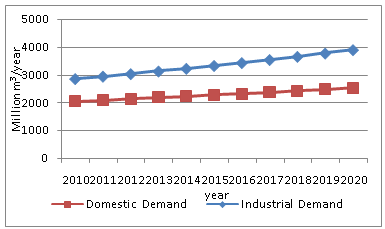 | Figure 3. Water Demand Forecast Results |
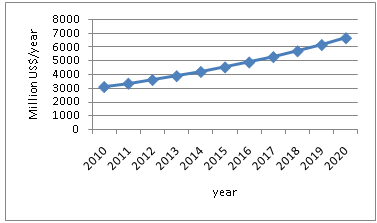 | Figure 4. Total Water Production Cost Forecast Results |
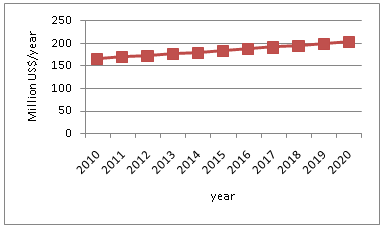 | Figure 5. Water Sale Revenue Forecast Results |
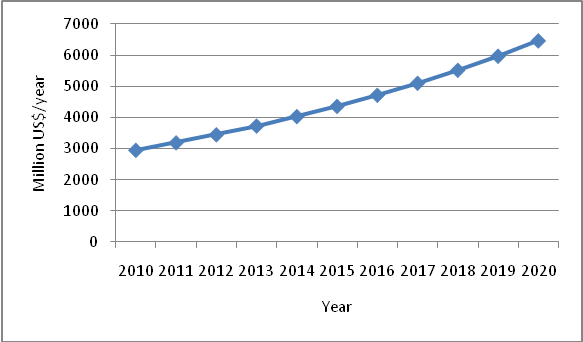 | Figure 6. Government Subsidy Forecast Result |
5. Conclusions and Recommendations
- KSA is facing a challenging water shortage problem where water demand is far exceeding the sustainable yields of natural resources. The country’s only reliable long-term water resources for municipal use are desalinated water and brackish groundwater. Groundwater resources are highly depleted. The marginal production cost of water in KSA is the desalinated water production cost. The desalinated water production cost is currently about 1.09 US$ per cubic metre. The KSA current water tariff system is heavily subsidized where people pay less than 5% of water production cost. Given the low cost of recovery and the rapidly increased demand water subsidy will become a very heavy load on the country’s budget. The government subsidy to water production will dramatically increase in the coming 10 years. The government subsidy will increase from about 2,596 million US$ in the year 2010 to about 6,472 million US$ in 2020. The current water tariff system does not support water conservation practices, while it is almost provided free for consumers. The majority of Saudi people believe that they do not pay a lot of money for water[4]. This shows the potential to increase the water price in KSA towards sustainable price. Comprehensive review of water tariff system is highly needed. The review objectives should be the development of a new tariff system and the development of a tariff system long and short term implementation plan. The new tariff system should have the capacity to enhance the economical efficiency of water services in the kingdom. The Kingdom’s socio-economical characteristics should be considered while developing the new tariff system implementation plan. The Ministry of Economic and Planning proposed a water tariff system that was unrealistic from implementation perspectives. Normal people will not be willing to accept fifty folds increases in water price at ones. Increase in prices should be implemented gradually and in a systematic way. KSA government will also need to take urgent demand management measures towards increasing the economic efficiency of the water system in the country including:• Water bill payments collection improvement • Enhance the water metering system for both domestic and industrial sectors• Reduce the unaccounted for water in water supply network through strong leakage detection program • A subsidized program for installing water efficient appliances and household water systems• Intensive water educational campaigns to increase the public awareness in water shortage problem and the actual cost of water production and distribution
ACKNOWLEDGEMENTS
- The author would like to thank his colleague at Prince Mohamed Fahd University, Khaled Fawagreh for his help in reviewing and editing this paper.
 Abstract
Abstract Reference
Reference Full-Text PDF
Full-Text PDF Full-text HTML
Full-text HTML